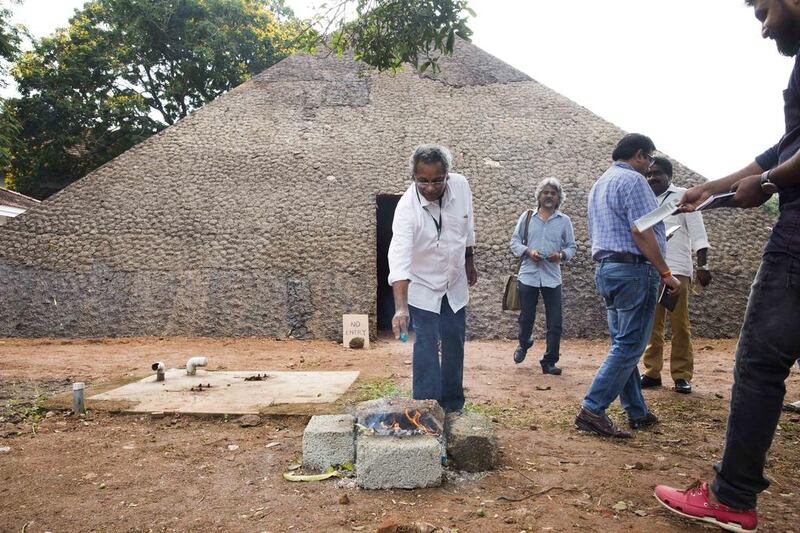Inside the pyramid, all was dark. Visitors advanced gingerly, each step accompanied by murmurs in 10 different languages.
Suddenly one voice was distinct: it was young Palestinian poet Asma’a Azaizeh, reciting words of exile penned by the late Palestinian master Mahmoud Darwish. “Our weight has become light like our houses in the faraway winds,” Azaizeh chanted in Arabic.
Lines from other troubled scribes resonated in Czech, Chinese, Indonesian, Latin, Spanish and Russian. Finally, at the exit, visitors were urged to burn copies of poems to “release the spirits” of the poets.
Conceived by Slovenian artist Aleš Šteger, The Pyramid of Exiled Poets – an Egyptian-style edifice oddly covered in cow dung – is proving to be one of the most popular and intriguing offerings at the Kochi-Muziris Biennale, a sprawling multimedia art exhibition in India's southern state of Kerala which runs until March 29. In keeping with the global news of refugee turmoil, a number of artworks explore loss and remembrance.
All the more reason to bask in the warm feeling exuded in Kochi. This historic port city has earned its reputation for hosting a “People’s Biennale”, galvanizing lots of young volunteers and the broad support of local shopkeepers, rickshaw drivers and folk musicians. At a time when a government-induced cash crunch has sharply reduced tourist inflows to Kerala, many locals seem particularly keen to welcome visitors.
They also don’t seem shy about participating. Nearly 25,000 people poured into the Biennale on January 2, on a Monday marked as a free day. Catalogues and street posters have been printed in the local language Malayalam, along with English. High school and college students have turned up in droves. But there’s still plenty of room to manoeuvre, given that the works are spread across 12 main venues, mostly capacious heritage buildings with a slightly raw edge.
As for the dress code, anything goes, including T-shirts, shorts and loose cotton tunics (slightly damp due to Kochi’s midday humidity). That enhances the collateral pleasures of eating, drinking and strolling along the riverside.
The casual, unpolished vibe is a far cry from the famed Venice Biennale, where designer fashions, high-powered gallery owners and yacht-toting millionaires cast a whiff of arrogance over the proceedings. There, admission is expensive, emulating the high display costs. In Kochi, however, a day-pass costs 100 rupees (Dh5.4), less than the price of a Bollywood film in a multiplex.
Jassim Nisaj, a local 19-year- old commerce student, said he was excited to mingle with so many artists while standing vigil at two venues for a modest allowance of 250 rupees per day. His father, a fisherman who straddles one of Kochi’s famed Chinese fishing nets, also got some part-time work unloading art and transporting it to the exhibition. “He told me that he liked the Pyramid,” said Nisaj.
For the organizers, there were problems in store before the opening on December 12. In neighbouring Tamil Nadu, the death of chief minister Jayalalithaa Jayaram paralyzed the Chennai port, stranding artwork. There was also a one-day strike across Kerala over currency shortages.
Everyone was affected by the cash scramble. The sweepers did not have bank accounts and could not be paid by cheque. A group of wall painters walked off the job. “Some people were upset,” recalled Kochi Biennale Foundation president Bose Krishnamachari. “They realised later, it was not our fault.”
He and others at the Foundation pooled their available personal cash, and managed to perk up the workers’ morale.
“When I went to sleep, I was rich. When I woke up in the morning, I was very poor,” chuckled veteran Emirati artist Mohammed Ahmed Ibrahim. In Kochi for a residency leading up to the Biennale, Ibrahim had just been paid 20,000 rupees in old notes by the organisers, and had withdrawn 10,000 rupees of his own money in old notes from an ATM. Then the new policy was announced, leaving him with just a fistful of valid 100 rupee notes.
It was a pinch, but he got by. The painter stopped buying art materials. Eschewing auto-rickshaws, he stuck close to his studio. And he resigned himself to eating out at slightly more expensive places, where credit cards were accepted.
Among his favourite works, Ibrahim also cited The Pyramid. While trading notes with other Kochi denizens, it became clear that Šteger's efforts to convert absence into a strongly-felt presence also found parallels elsewhere: in fine and widely divergent works by Raúl Zurita of Chile, Gabriel Lester of the Netherlands, Avinash Veeraraghavan of India and Éva Magyarósi of Hungary. One of the most memorable Biennale experiences was Symphony of a Missing Room, an eerie audio tour concocted by Swedish artists Christer Lundahl and Martina Seitl.
Who else was missing? At the inauguration, one minister asked the crowd to observe a moment of silence for the passing of Fidel Castro. The nod to Cuba’s erstwhile president was a reminder of the state’s rich history of leftist politics. Turning to a visiting Frenchman, Bangalore-based artist Shanthamani Muddaiah explained: “This is Kerala.”
Margot Cohen is a writer based in New York.










